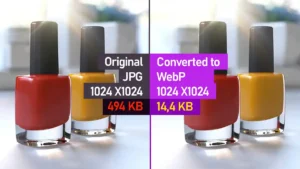
Optimizing images for the internet is essential for any content creator. Using an efficient converter like the WebP Converter can transform your site's performance. With WebP, you ensure fast loading times and save mobile data for users.
The WebP Converter not only converts to WebP format but also to other popular formats like JPEG and PNG. Best of all, it’s free and simple to use. Let's explore how this tool can benefit your content.
By optimizing your images with WebP, you improve your site’s ranking, making it lighter and gaining points in Google Core Web Vitals. Learn how to use the tool and the advanced options to customize your conversions.
Why is Image Optimization Crucial for the Internet?
Unoptimized images can significantly increase a page’s loading time. This is especially problematic for users on mobile devices with slower internet connections. Therefore, optimizing your images is an essential step to reach a larger audience.
WebP Converter ensures your images maintain high quality while reducing file size, improving site speed and user experience. This is crucial for keeping visitors engaged and reducing bounce rates.
How Does the WebP Image Converter Work?
The WebP Converter is a powerful and easy-to-use tool. Simply follow these steps to convert your images:
- Click 'Select Files' or drag your files into the dotted area to upload your images.
- Select the desired format from the list of options.
- Click 'Convert Images' and wait for the process to complete.
- Download your converted images for free.
The conversion process is fast and secure. In just a few seconds, your images will be ready for download. The WebP Converter supports multiple formats, allowing flexibility in your choice according to specific needs.
Additionally, the tool offers advanced options to customize your conversions. You can resize images, adjust quality, and choose the compression level. These options ensure you get exactly what you need for each project.
- Images will be resized proportionally in width and height.
- Adjust quality from 0 to 100. The default is 70.
- For better performance on smartphones, we recommend a quality of 40.
Benefits of WebP for Content Creators
The WebP format offers a range of advantages for content creators, designers, and marketing professionals. One of the main advantages is the reduction of image file sizes without compromising quality, resulting in faster loading times.
WebP images are ideal for websites and applications, as they improve the user experience by reducing mobile data consumption. This is especially important in a world where mobile internet access is rapidly growing.
Moreover, using WebP can help improve your site's SEO. Google values page loading speed, and optimized images contribute directly to better search results rankings.
Tips for Image Optimization for the Internet
To ensure your images are always optimized, follow some important tips. Use high-quality images from the start to avoid losing details during conversion. Choose the appropriate image format for each situation: PNG for transparent backgrounds, JPEG for efficient compression, and WebP for the best overall performance.
Resize your images to the exact dimensions needed to save space and improve site speed. Adjust image quality based on the specific needs of each project. For mobile content, a quality of 40 is recommended for better performance.
Use our free Contributors Keyword tool, developed for Getty Images and iStock Photo photographers, to optimize your images' SEO. This will help attract more visitors to your site, ensuring your content is easily found.
Frequently Asked Questions about Image Optimization


How to Recover from Burnout for Creatives and Tech professionals

How Adobe AI and Subscriptions are Reshaping Creativity.

Graphic Design and ByteByteGo: Simplifying Complex Concepts
